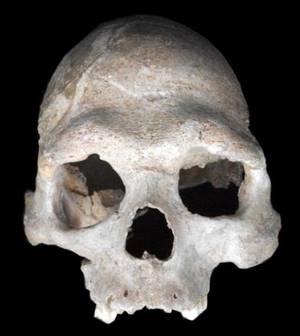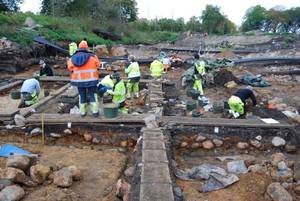Press Releases Archive
17.09.2014
Genetic Makeup of Europeans
Researchers compare ancient hunter-gatherers and early farmers to present-day human genomes and find that Europeans today trace their ancestry to three ancient populations
The beginning of agriculture and animal domestication, which began in the Near East before 11,000 years ago, had a tremendous impact on human lifestyle. Hunter-gatherers were replaced in many places by sedentary farmers, and there were large increases in population size that laid the foundation for larger towns and eventually complex societies. Archaeological evidence suggests that the transition to a farming lifestyle in central Europe occurred around 7,500 years ago, with the appearance of the Linearbandkeramik (LBK), a sedentary farming culture. It has long been debated whether that change in subsistence strategy involved the mass migration of people from the Near East bringing innovative technologies and domestic animals to Europe or whether it was due to a transmission of cultural practices passed on from neighbouring populations. Recent genetic studies on ancient hunter-gatherers and early farmer remains have suggested a massive migration of people to Europe coinciding with the spread of farming. The size and distribution of the genetic components contributed to indigenous European hunter-gatherers, however, remain unclear.
An international consortium led by researchers from the University of Tübingen and Harvard Medical School analyzed ancient human genomes from a ~7,000-year-old early farmer from the LBK culture from Stuttgart in Southern Germany, a ~8,000-year-old hunter-gatherer from the Loschbour rock shelter in Luxembourg, and seven ~8,000-year-old hunter-gatherers from Motala in Sweden. In order to compare the ancient humans to present-day people, the team also generated genome-wide data from about 2,400 humans from almost 200 diverse worldwide contemporary populations.
Their surprising finding was that present-day Europeans trace their ancestry back to three and not just two ancestral groups: The first is indigenous hunter-gatherers; the second is Near Eastern farmers that migratedto Europe around 7,500 years ago; and a novel third is a more mysterious population that spanned North Eurasia and genetically connects Europeans and Native Americans. “We find a major surprise: Europeans are a mixture of three ancient populations, not two,” says David Reich from Harvard Medical School, one of the lead investigators of the new study. “We had previously found an ancient genetic link of present-day Europeans and Native Americans,” adds Nick Patterson from the Broad Institute in Boston. “To our surprise this component was not present in the ancient hunter-gatherer from Luxembourg, nor was it present in the first European farmers”.
“It seems clear now that the third group linking Europeans and Native Americans arrives in Central Europe after the early farmers,” explains Johannes Krause from the University of Tübingen and director of the Max Planck Institute for History and Sciences in Jena, Germany. “We are however not sure yet when the Northern Eurasian component enters central Europe”
Using the large dataset of present-day and ancient human data, the researchers were able to calculate the proportion of the ancestral components in present-day Europeans. "Nearly all Europeans have ancestry from all three ancestral groups," says Iosif Lazaridis from Harvard Medical School. "Differences between them are due to the relative proportions of ancestry. Northern Europeans have more hunter-gatherer ancestry—up to about fifty percent in Lithuanians—and Southern Europeans have more farmer ancestry." However, he cautions: "Even the early farmers themselves had some hunter-gatherer ancestry: They were not unmixed descendants of the original Near Eastern migrants that brought farming to Europe." How Europeans received their Northern Eurasian ancestry remains an open question: "The Northern Eurasian ancestry is proportionally the smallest component everywhere in Europe, never more than twenty per cent, but we find it in nearly every European group we've studied and also in populations from the Caucasus and Near East. A profound transformation must have taken place in West Eurasia after the Neolithic Revolution."
The researchers also analyzed genes with known phenotypic association and show that some of the hunter-gatherers likely had blue eyes and darker skin, whereas the early farmers had lighter skin and brownish eyes. Both the hunter-gatherers as well as the early farmers displayed high copy numbers of amylase genes in their genomes, suggesting that both populations had already adapted to a starch-rich diet. However, none of the ancient humans was yet adapted to digest milk sugar into adulthood.
The researchers were also able to fit the genomic data of modern and ancient humans into a simplified genetic model to reconstruct the deep population history of modern humans outside Africa in the last 50,000 years. While the model suggests that present-day Europeans received contributions from at least three ancestral populations, it also suggests that Early Near Eastern farmers carried genetic material that falls outside the typical non-African variation. “The finding of an ancient lineage that is present in Europeans and Near Easterners but not elsewhere in Eurasia was a major surprise of our study. It will be exciting to carry out further ancient DNA work to understand the archaeological cultures associated with the arrival of this ancestry,” says David Reich. “We are only starting to understand the complex genetic relationship of our ancestors,” adds Johannes Krause. “Only more genetic data from ancient human remains will allow us to disentagle our pre-historic past”.
Publication:
Iosif Lazaridis, Nick Patterson, Alissa Mittnik, Gabriel Renaud, Swapan Mallick, Karola Kirsanow, Peter H. Sudmant, Joshua G. Schraiber, Sergi Castellano, Mark Lipson, Bonnie Berger,, Christos Economou, Ruth Bollongino, Qiaomei Fu, Kirsten I. Bos, Susanne Nordenfelt, Heng Li, Cesare de Filippo, Kay Prüfer, Susanna Sawyer, Cosimo Posth, Wolfgang Haak, Fredrik Hallgren, Elin Fornander, Nadin Rohland, Dominique Delsate, Michael Francken, Jean-Michel Guinet, Joachim Wahl, George Ayodo, Hamza A. Babiker, Graciela Bailliet, Elena Balanovska, Oleg Balanovsky, Ramiro Barrantes, Gabriel Bedoya, Haim Ben-Ami, Judit Bene, Fouad Berrada, Claudio M. Bravi, Francesca Brisighelli, George B. J. Busby, Francesco Cali, Mikhail Churnosov, David E. C. Cole, Daniel Corach, Larissa Damba, George van Driem, Stanislav Dryomov, Jean-Michel Dugoujon, Sardana A. Fedorova, Irene Gallego Romero, Marina Gubina, Michael Hammer, Brenna M. Henn, Tor Hervig, Ugur Hodoglugil, Aashish R. Jha, Sena Karachanak-Yankova, Rita Khusainova, Elza Khusnutdinova, Rick Kittles, Toomas Kivisild, William Klitz, Vaidutis Kucinskas, Alena Kushniarevich, Leila Laredj, Sergey Litvinov, Theologos Loukidis, Robert W. Mahley, Bela Melegh, Ene Metspalu, Julio Molina, Joanna Mountain, Klemetti Näkkäläjärvi, Desislava Nesheva, Thomas Nyambo, Ludmila Osipova, Jüri Parik, Fedor Platonov, Olga Posukh, Valentino Romano, Francisco Rothhammer, Igor Rudan, Ruslan Ruizbakiev, Hovhannes Sahakyan, Antti Sajantila, Antonio Salas, Elena B. Starikovskaya, Ayele Tarekegn, Draga Toncheva, Shahlo Turdikulova, Ingrida Uktveryte, Olga Utevska, Rene´ Vasquez, Mercedes Villena, Mikhail Voevoda, Cheryl A. Winkler, Levon Yepiskoposyan, Pierre Zalloua, Tatijana Zemunik, Alan Cooper, Cristian Capelli, Mark G. Thomas, Andres Ruiz-Linares, Sarah A. Tishkoff, Lalji Singh, Kumarasamy Thangaraj, Richard Villems, David Comas, Rem Sukernik, Mait Metspalu, Matthias Meyer, Evan E. Eichler, Joachim Burger, Montgomery Slatkin, Svante Pääbo, Janet Kelso, David Reich & Johannes Krause:
Ancient human genomes suggest three ancestral populations for present-day Europeans. Nature, doi:10.1038/nature13673
Contact:
Johannes Krause
University of Tübingen
Institute for Scientific Archaeology (INA)
phone: +49 7071 29-74089
<link mail ein fenster zum versenden der>johannes.krause[at]uni-tuebingen.de
Max-Planck-Institut für Geschichte und Naturwissenschaften
Kahlaische Str. 10 ∙ 07745 Jena
Telefon: +49 3641-686-700
David Reich
Department of Genetics,
Harvard Medical School,
Boston, USA
phone: +1 (617) 432-6548
<link mail ein fenster zum versenden der>reich[at]receptor.med.harvard.edu
 |  |
| (A) Skull of the approximately 8,000 year old hunter-gatherer male from the Loschbour rock shelter in Luxembourg whose genome was sequenced. Credit: Dominique Delsate, Musée national d'Histoire naturelle de Luxembourg. | (B) Skull of the approximately 7,000 year old farmer females from Stuttgart in Germany, missing the lower right molar from which DNA was extracted. Credit: Joanna Drath, University of Tübingen. |
 |  |
| (C) Excavation at Kanaljorden in Motala, Sweden, the source of the seven approximately 8,000 year old hunter-gatherers sequenced in this study. Credit: Fredrik Hallgren | (D) The skull of Motala1, one of the seven approximately 8,000 year old Swedish hunter-gatherers sequenced in this study. Credit: Fredrik Hallgren |
